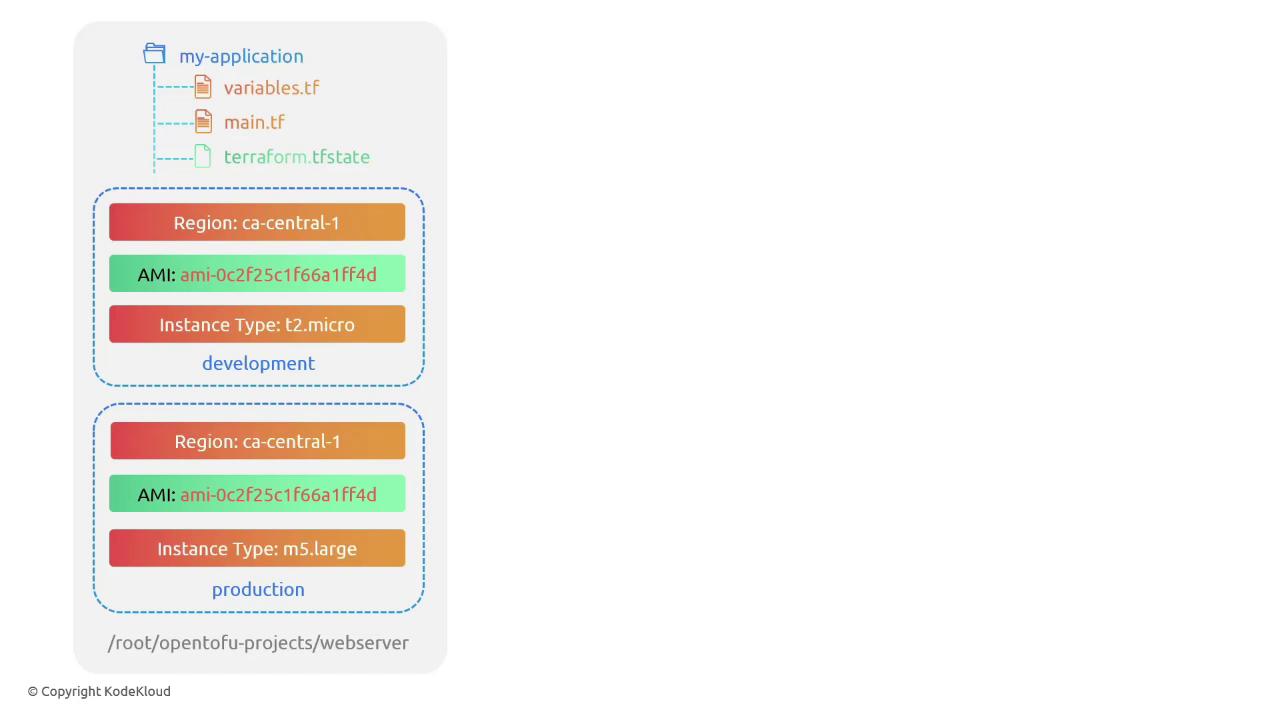OpenTofu: A Beginners Guide to a Terraform Fork Including Migration From Terraform
OpenTofu Functions and Conditional Expressions
OpenTofu Workspaces
Every OpenTofu configuration uses a state file to track and manage resources. By default, there’s a single workspace named default. To create multiple environments (for example, development and production) from the same configuration directory, you can use workspaces to isolate state files.
Listing the Default Workspace
Run:
$ tofu workspace list
* default
The asterisk (*) indicates the currently active workspace.
Creating and Switching Workspaces
Create and switch to new workspaces:
$ tofu workspace new production
Created and switched to workspace "production"!
$ tofu workspace new development
Created and switched to workspace "development"!
Note
Each workspace has its own isolated state. New workspaces start empty until you run tofu apply.
Listing again shows the active workspace:
$ tofu workspace list
default
production
* development
Workspace Commands Reference
| Command | Description |
|---|---|
tofu workspace list | List all available workspaces |
tofu workspace new <name> | Create and switch to a new workspace |
tofu workspace select <name> | Switch to an existing workspace |
Using Workspaces in Configuration
Suppose your project directory at /root/opentofu/projects/webserver defines an AWS EC2 instance. You need:
- Development:
t2.micro - Production:
m5.large - Region:
ca-central-1 - AMI: same for both environments

Update variables.tf to define instance_type as a map:
variable "ami" {
default = "ami-24e140119877avm"
}
variable "region" {
default = "ca-central-1"
}
variable "instance_type" {
type = map(string)
default = {
development = "t2.micro"
production = "m5.large"
}
}
In main.tf, use lookup with terraform.workspace and add dynamic tags:
resource "aws_instance" "webserver" {
ami = var.ami
instance_type = lookup(var.instance_type, terraform.workspace)
tags = {
Environment = terraform.workspace
}
}
Verifying Workspace Values
Open the OpenTofu console to inspect workspace-specific values:
$ tofu console
> terraform.workspace
development
> lookup(var.instance_type, terraform.workspace)
t2.micro
$ tofu workspace select production
> terraform.workspace
production
> lookup(var.instance_type, terraform.workspace)
m5.large
Applying Changes per Workspace
In the development workspace:
$ tofu workspace select development
$ tofu apply
OpenTofu will plan:
# aws_instance.webserver will be created
+ resource "aws_instance" "webserver" {
+ ami = "ami-24e140119877avm"
+ instance_type = "t2.micro"
+ tags = {
+ "Environment" = "development"
}
}
Switch to production and apply:
$ tofu workspace select production
$ tofu apply
OpenTofu will plan:
# aws_instance.webserver will be created
+ resource "aws_instance" "webserver" {
+ ami = "ami-24e140119877avm"
+ instance_type = "m5.large"
+ tags = {
+ "Environment" = "production"
}
}
Local State File Organization
When using local state, OpenTofu organizes workspace-specific state under terraform.tfstate.d:
$ ls
main.tf provider.tf terraform.tfstate.d variables.tf
$ tree terraform.tfstate.d/
terraform.tfstate.d/
├── development
│ └── terraform.tfstate
└── production
└── terraform.tfstate
2 directories, 2 files
Each subdirectory holds the terraform.tfstate file for its workspace.
That's it for this lesson. See you in the next one!
Watch Video
Watch video content